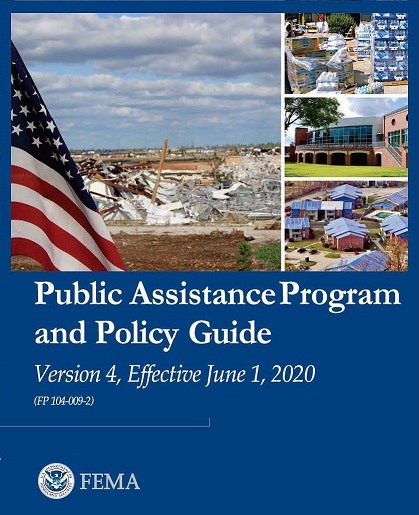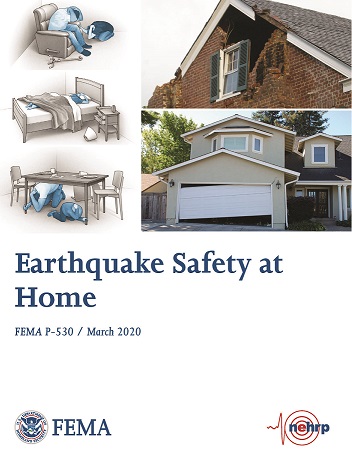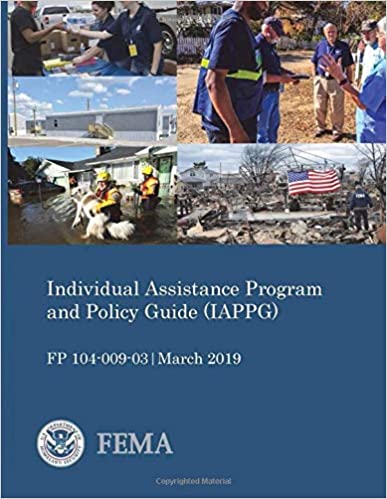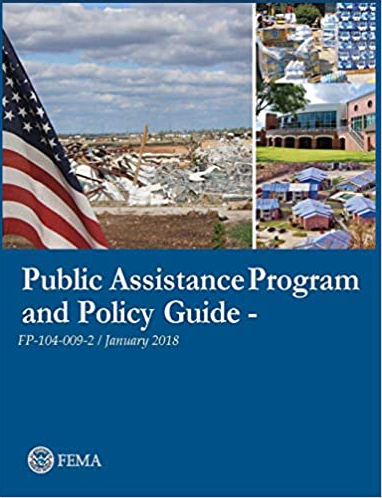

 |
FEMA's Public Assistance (PA) Program is FEMA's largest grant
program. The 2020 FEMA Public Assistance Program and Policy Guide
(PAPPG) is FEMA's PA bible. This is the Fourth Edition (Version 4) of the Public Assistance Program and Policy Guide (PAPPG). FEMA applies this Version 4 to incidents declared on or after June 1, 2020. It supersedes Version 3.1. Version 4 covers many programs introduced by FEMA prior to its publication: FEMA has incorporated the Public Assistance Alternative Procedures for Permanent Work Pilot Policy (FP 104-009-7). This establishes Alternative Procedures as the first option considered for all large permanent work projects in order to ensure the ability of Applicants to drive their own recovery. It standardizes a single process for the development and consideration of fixed cost estimates for all permanent work projects. Applicants will be able to agree to a fixed cost estimate or choose to pursue funding under standard, actual cost procedures. This approach maximizes Applicant awareness of the opportunities and benefits provided by the Alternative Procedures, which include, but are not limited to: • Flexibility in meeting
post-disaster recovery needs, as opposed to being limited to rebuilding
back to what existed prior to the disaster;
Appendix M: Alternative Procedures for Permanent Work Pilot, provides
additional information along with a summary of benefits in comparison
to the standard Public Assistance (PA) procedures.• Ability to share funds across all Alternative Procedures Permanent Work Projects; • Ability to retain and use excess funds to reduce risk and improve future disaster operations (subject to timely closeout); and • Eligibility for cost-effective hazard mitigation on replacement projects. Order on Amazon |
 |
The
DisasterCenter.com is please to be able to make available a print
version of
FEMA’s Earthquake Safety at Home. This guide will show you
why you should care about
earthquakes wherever you live, and how you can Prepare,
Protect,
Survive, Respond, Recover and Repair. It will help you become
familiar with why and where earthquakes might occur and discuss steps
you can take
to adequately prepare and protect yourself, your family, and your
belongings.
These steps are wide ranging and include actions to prepare for an
earthquake,
such as developing family response plans, assembling earthquake
disaster
supplies, securing heavy objects and furniture, retrofitting your home,
and
more. During and immediately after an earthquake, guidelines for
survival will
help keep your family safe. Following an earthquake, recommendations
for
recovery and repair will help your family resume regular activities as
quickly
as possible. The guide has been
organized beginning with a
brief introduction of earthquake risks throughout America followed by
actionable advice for earthquake safety. The Respond
section
includes a
post-earthquake Home
Safety Checklist. Readers using the
electronic version of this document can hover over and click online
resource
references to be taken to the source website. A list of resources is
provided
at the end of this document. You are encouraged to read the entire
document in
the order presented, or you can skip to a topic of particular interest. |
 |
The Federal Emergency Management Administration's (FEMA)
Individual Assistance Program and Policy Guide (IAPPG) consolidates
information on Individual Assistance (IA) programs offered by FEMA to a
state, territorial, tribal, or local government jurisdiction affected
by a disaster. The IAPPG:•Supersedes all stand-alone Individual Assistance policies and program guides currently located in FEMA documents and standard operating procedures (SOPs), including the 2016 Individuals and Households Program Unified Guidance (IHPUG); Provides a comprehensive guide to programs and activities available to the state, territory, tribe, or local government following a disaster; Increases consistency in implementation, collaboration in planning, and the sharing of knowledge between states, territories, tribes, local governments, FEMA and other Federal and non-Federal entities who assist disaster survivors; Eligibility for Federal assistance is based on each applicant’s indivand,idual circumstances as they relate to each program’s conditions of eligibility. Not all applicants will be eligible for all forms of Federal assistance.The Individual Assistance Program and Policy Guide is used to determine the Conditions of Eligibility for:•Mass Care and Emergency Assistance•Individuals and Households Program Assistance •Disaster Case Management •Crisis Counseling Assistance and Training Program •Disaster Legal Services •Disaster Unemployment Assistance Available from Amazon |
 |
DisasterCenter.com is pleased to be able to make available,
in print format, the Low-Volume Roads Engineering -- Best
Management Practices Field Guide This guide tries to address most basic roads issues in as simple a manner as possible. Complex issues should be addressed by experienced engineers and specialists. Included are key “DO’s” (RECOMMENDED PRACTICES) and “DON’Ts” (PRACTICES TO AVOID) in low-volume roads activities, along with some relevant basic design information. These fundamental practices apply to roads worldwide and for a wide range of road uses and standards. Often recommended practices have to be adapted to fit local conditions and available materials. Additional information on how to do the work is found in other Selected References, such as the “Minimum Impact Low-Volume Roads Manual”. Most practices apply to a wide range of road standards, from native surfaced, single-lane roads to double-lane paved roads. Desirable general practices include good road planning and location, performing environmental analysis, recognizing the need for positive surface drainage, ensuring adequately sized drainage crossing structures, using stable cut and fill slopes, using erosion control measures, developing good materials sources, and reclaiming sites once work has been completed. Certain design practices, such as use of rolling dips, outsloped roads, or low-water stream crossings, are very cost-effective and practical but typically apply to low-volume, low-speed roads because of safety concerns, vertical alignment issues, or unacceptable traffic delays. Local rules, agency policies or regulations, or laws may conflict with some of this information or may include more specific information than that included herein. Thus, good judgment should be used in the application of the information presented in this guide, and local regulations and laws should be followed or modified as needed. |
 |
Verison 3 of FEMA's Public Assistance Program is FEMA's
PA Policy Guide and covers Major Federal Disaster Declarations between
August 22, 2017 to June 1, 2020 FEMA's Public Assistance Program is the largest grant program that FEMA operates. FEMA PA can assist with local and State governments’ emergency response efforts and in the restoration of public infrastructure after Presidential disaster declarations in the United States. FEMA may provide financial assistance to private nonprofit facilities as defined by Section 102 of the Robert T. Stafford Disaster Relief and Emergency Assistance Act (42 U.S.C. § 5122(11)) (Stafford Act) and 44 C.F.R. § 206.221. The Stafford Act authorizes FEMA to provide assistance to private nonprofit facilities, including community centers. 44 C.F.R. § 206.221(e)(7). This Public Assistance Program and Policy Guide continues to define community centers to include facilities that provide a wide array of services, including but not limited to art classes, gardening, sewing, stamp collecting, community clean-up projects, and activities to pursue items of mutual interest, concern or social engagement. The FEMA Public Assistance Program and Policy Guide (PAPPG) is FEMA's PA bible. The PAPPG combines all Public Assistance (PA) policy into a single volume and provides an overview of the PA Program implementation process with links to other publications and documents that provide additional process details. This document incorporates and supersedes language from PA Program publications and 9500 Series documents The 2018 PAPPG (V3.0) is effective for all emergencies and major disasters declared on or after August 23, 2017. It supersedes the 2017 PAPPG (V2.0) which is effective for all emergencies and major disasters declared between April 1, 2017 and August 22, 2017 |